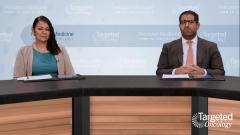
CEACAM5: Role, Expression, and Therapeutic Potential in NSCLC
The role of CEACAM5, its expression in NSCLC, and its potential as a therapeutic target are thoroughly examined, including its impact on tumorigenesis and prognosis in NSCLC patients.
Episodes in this series

Joshua Sabari: So diving deeper into CEACAM5. You mentioned CEA right carcinoembryonic antigen. We knew about this marker for 50 plus years. This is a family of 12 different cell adhesion molecules, right. And interestingly, CEACAM5, highly expressed in malignant tissue, epithelial tissue. We see it in low level expression in some normal tissues. But really in in cancer, particularly the non squam. The adenocarcinoma, GI, as well as lung, non-small cell lung cancer and specific. Very high levels of expression. And it's potential honing marker. Or an ability to deliver cytotoxic chemotherapy. There's a new field of therapeutics called ADCs, or antibody drug conjugates. Want to maybe explain to us sort of what that concept is and how do you think about antibody drug conjugates in your clinical practice?
Narjust Florez: Tobe honest, when I think about ADCs, antibody drug conjugates, I think are the drugs that were administered in the future. The future is now. So these tend to be very complex drugs. They usually have a monoclonal antibody, a linker, and then a payload. It's a very complex structure. The monoclonal antibody tends to target the antigen. The one that we know the most is HER2. But we have more and more under development. The antibody goes and attaches to that antigen and the top of the cell. The linker releases that payload intracellularly, which tends to be chemotherapy. Can be a topoisomerase inhibitor, it can be a microtubule inhibitor. But when I see it and I explain it to my patients, it feels like it is the drug of the future right. It feels like we're in a little episode of a movie directed by somebody in 2030. This is what our antibody drug conjugate is. It's targeted therapy to the molecular level attached to chemotherapy, which we know very well. What I really - It makes me inside about ADCs is that, it not only affects that cell that the drug that antibody attaches to, we also know about the bystander effect. We can affect the cells in the vicinity, or the ADC that is a minister. Even if the cell is not targeted by that monoclonal antibody, we have seen apoptosis and dead cell death, and the cells and the vicinity. It's like, when I try to explain to my patients the bystander effect is when you try to spray your dandelions, but you ain't killing your roses. That's what I think the bystander effect is when I try and explain it to my patients.
Joshua Sabari: Definitely not good to kill the roses. Thinking about - Is this a targeted therapy? Is this a chemotherapy? This is a different era. We have targeted therapies that are small molecules, tyrosine kinase inhibitors, as well as antibodies that are targeting. This is a targeted chemotherapy, as you mentioned. Tusamitamab ravtansine is a CEACAM5 antibody linked to a toxic payload. This is a mAb, linker, payload with a cleavable Linker. As you mentioned, we're able to deliver this high dose of chemotherapy specifically to cancer cells. Does it matter what the level of expression of CEACAM5 is on the efficacy of agents to submit a tusamitamab ravtansine?
Narjust Florez: That's a very good question. But so far, we have studied mostly in highest pressors. How do we test for CEACAM5 right? Well, compared to some of those other molecular targets, we do immuno-histochemical. Immuno-histochemical is like your first car. Your car in 1995. Still will get you to places and it will break down. We're very familiar with it. Immuno-histochemical at the cell level, and the membrane expression in the tumor cell expression, we usually consider it to be positive is to plus or higher than 50%. These are the patients that have been enrolled mostly in clinical trials. What percentage of patients with adenocarcinoma squamous are positive for CEACAM5 is surprisingly highs. 25% of patients. When we talk about other targets, we don't have those a high percentage of patient having this high expression. But it is very important when we try to test for CAECAM5, we have to have open communication with your pathologist. Because this is not included in your next due sequencing. This is not included in your panel. It needs to be tested by IHC, by your friendly pathologist to determine their expression and to determine if the patient can qualify for these therapies in the future. What I really like about CEACAM5 is it brings back the importance of immuno-histochemical. How we as medical oncologists need to partner with our pathologist and learn from them and work together. There's a lot of research that still needs to be done. Because as we know IHC is no perfect. We can have highest pressure in some parts of the tumor, and lower blood pressure in other parts of the tumor. Which brings a very good point about bias with biopsy. But it's still under development to plus of 50%, are some of the patients that are considered to be high for CEACAM5 and immuno-histochemical testing. But something that's very exciting for me is that, you don't see it in normal lung tissue. Making a very important target, because the lung tissue will know uptake the stain, and we allow you to have a clear target.
Joshua Sabari: We definitely don't want to target normal tissues in the body. I agree with you. Having a biomarker that is really selective for malignant cells is key in differentiating the activity and potentially the toxicity of some of these agents.







































